unit4 global warming[上学期]
文档属性
| 名称 | unit4 global warming[上学期] | 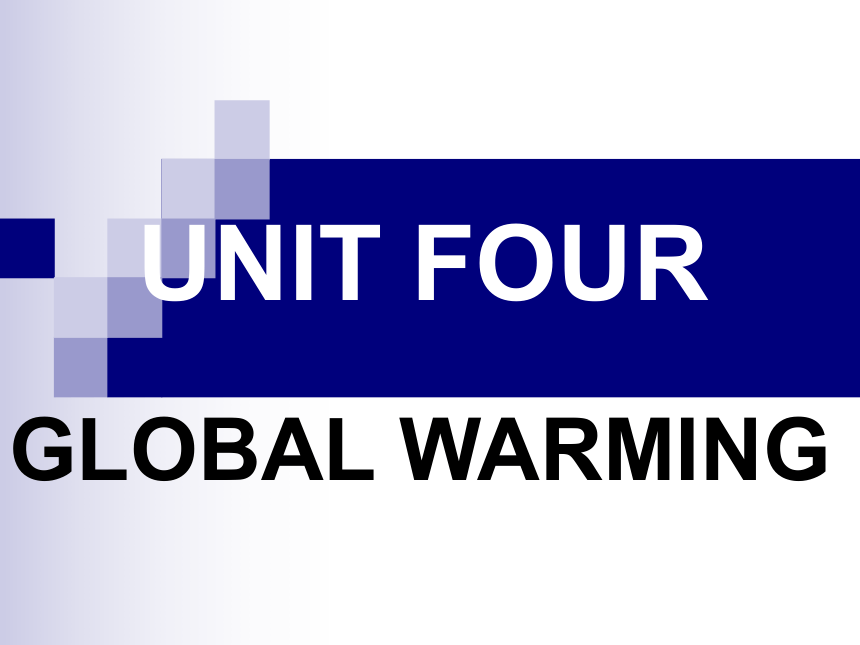 | |
| 格式 | rar | ||
| 文件大小 | 1.1MB | ||
| 资源类型 | 教案 | ||
| 版本资源 | 通用版 | ||
| 科目 | 英语 | ||
| 更新时间 | 2006-12-20 23:25:00 | ||
图片预览

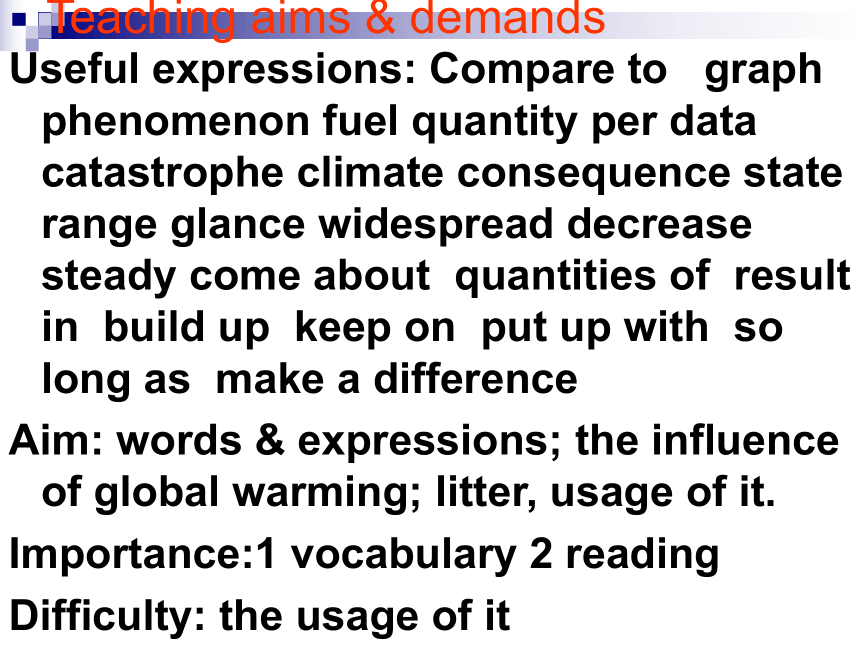
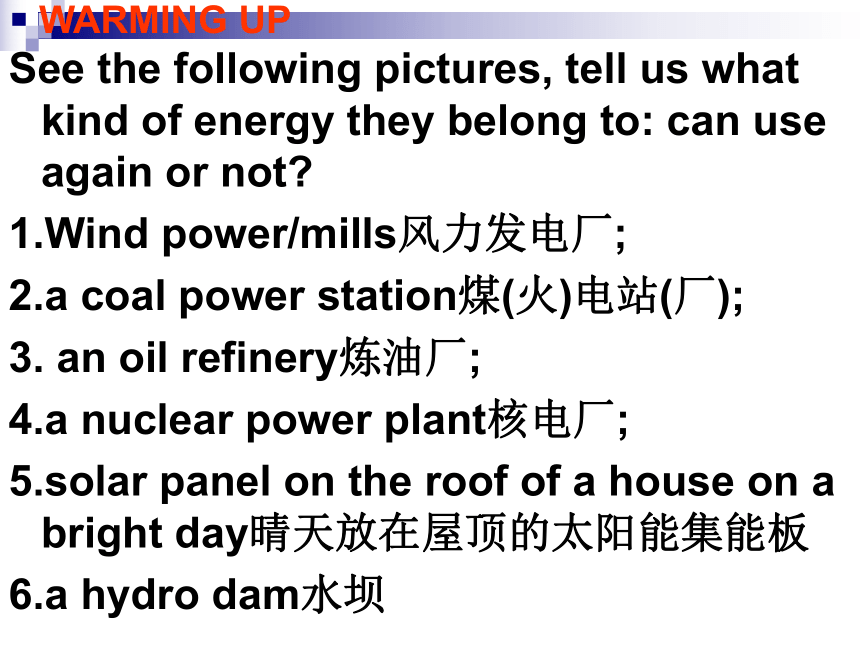
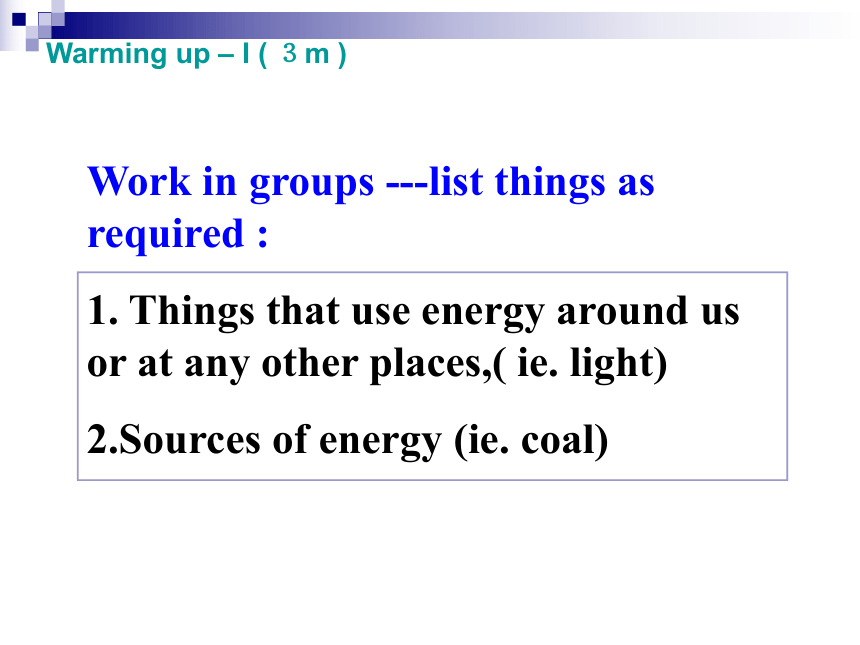
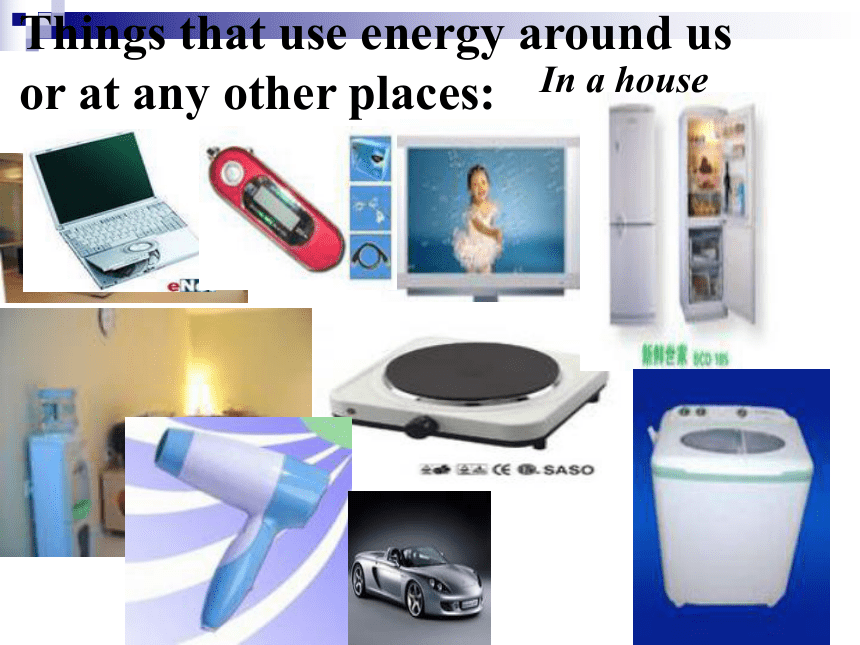
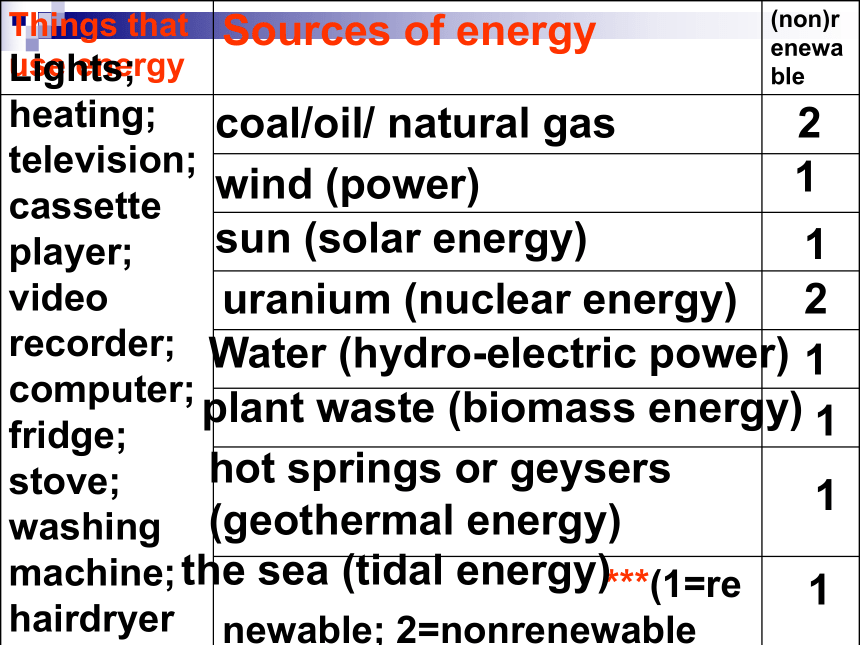
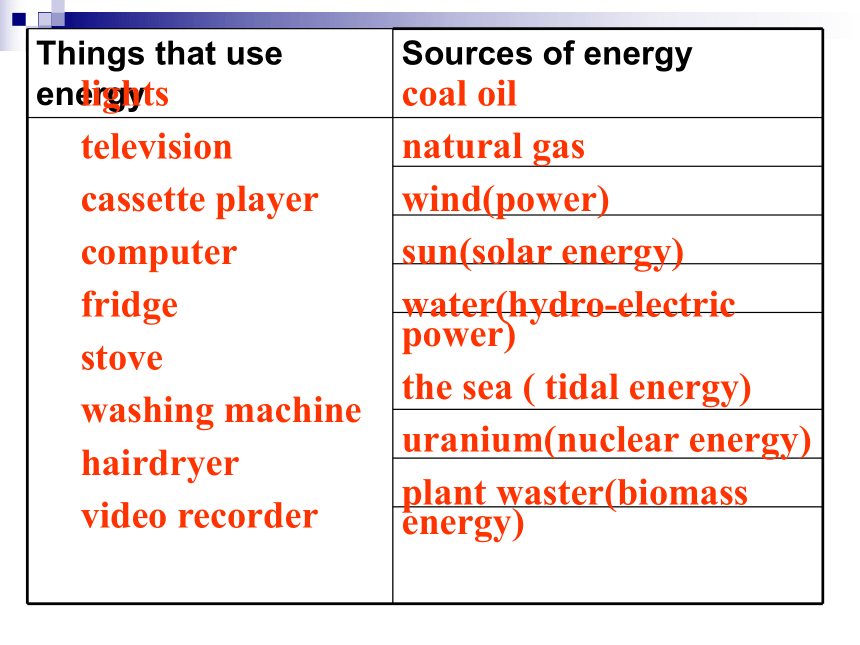
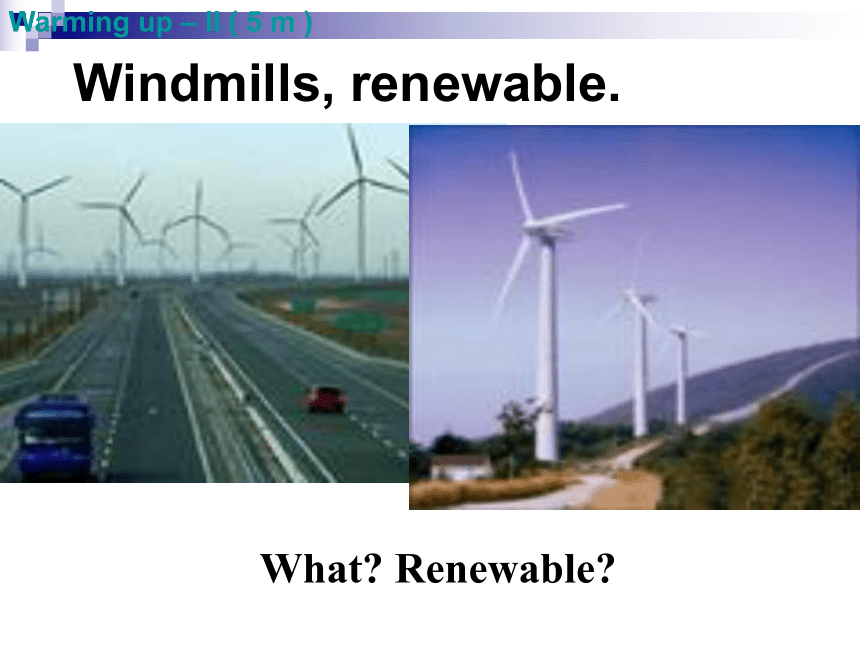
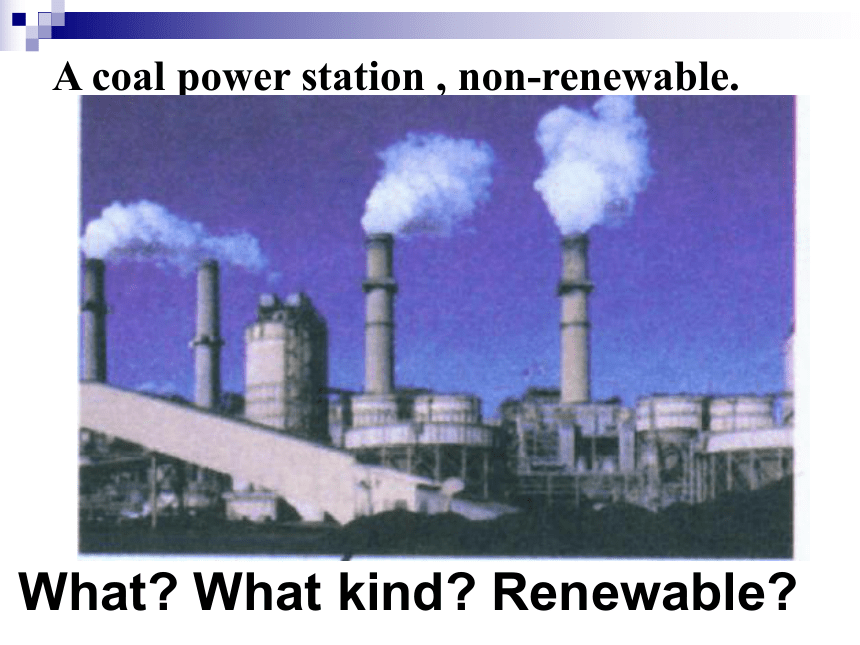
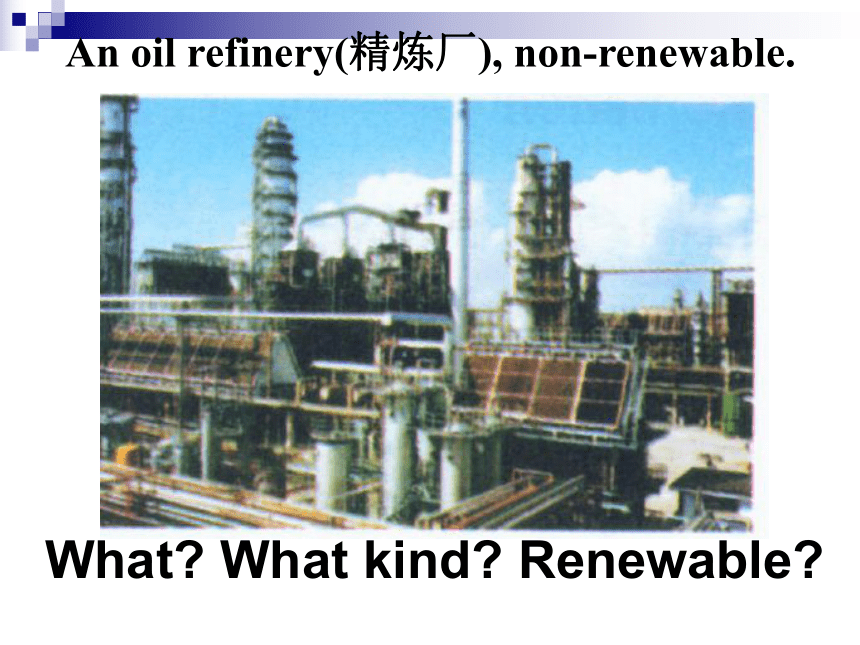
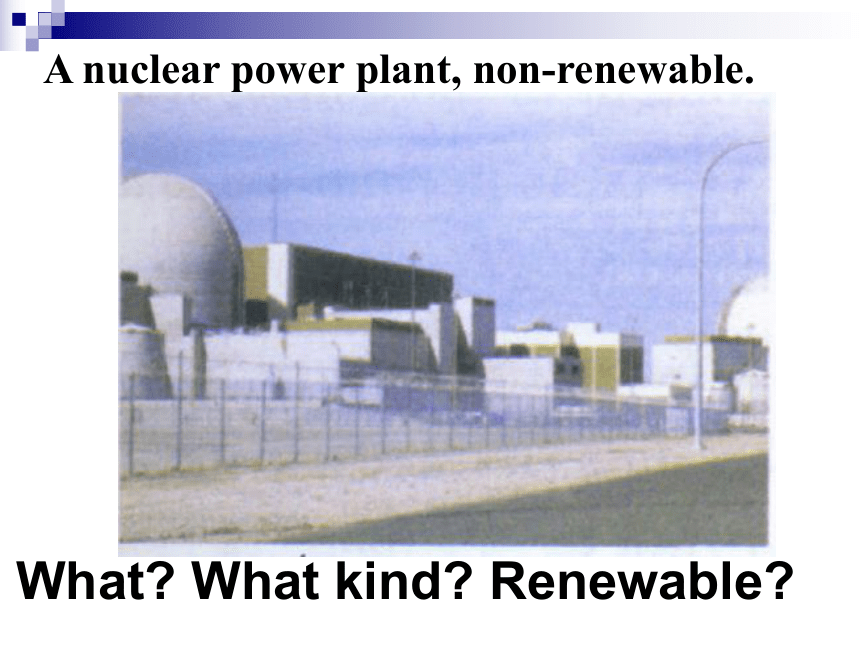
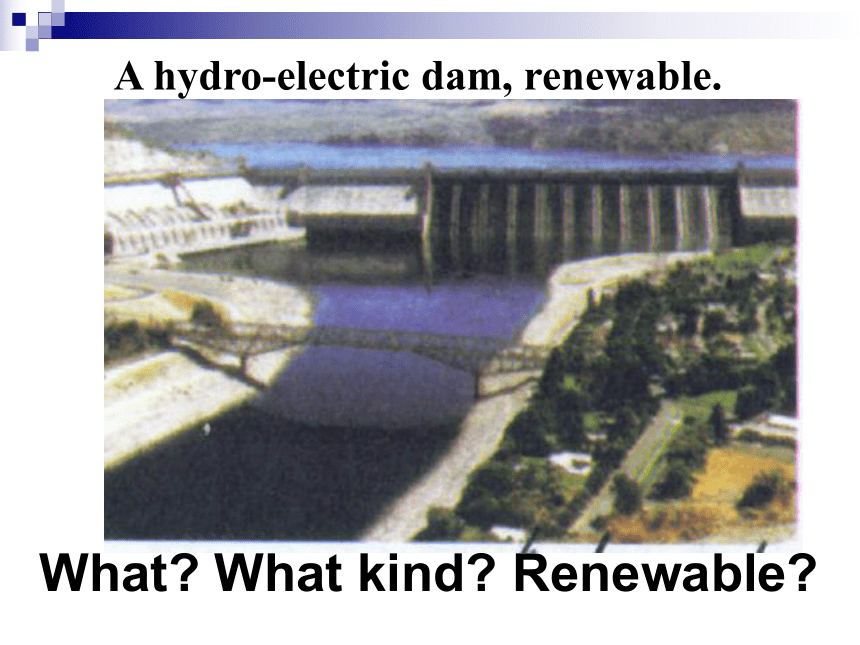
文档简介
课件100张PPT。UNIT FOURGLOBAL WARMINGTeaching aims & demandsUseful expressions: Compare to graph phenomenon fuel quantity per data catastrophe climate consequence state range glance widespread decrease steady come about quantities of result in build up keep on put up with so long as make a difference
Aim: words & expressions; the influence of global warming; litter, usage of it.
Importance:1 vocabulary 2 reading
Difficulty: the usage of itWARMING UPSee the following pictures, tell us what kind of energy they belong to: can use again or not?
1.Wind power/mills风力发电厂;
2.a coal power station煤(火)电站(厂);
3. an oil refinery炼油厂;
4.a nuclear power plant核电厂;
5.solar panel on the roof of a house on a bright day晴天放在屋顶的太阳能集能板
6.a hydro dam水坝Work in groups ---list things as required :
1. Things that use energy around us or at any other places,( ie. light)2.Sources of energy (ie. coal)Warming up – I ( 3m ) Things that use energy around us or at any other places:In a houseLights; heating; television; cassette player; video recorder; computer; fridge; stove; washing machine; hairdryercoal/oil/ natural gaswind (power)21sun (solar energy)1uranium (nuclear energy)2Water (hydro-electric power)1plant waste (biomass energy)1hot springs or geysers (geothermal energy)1the sea (tidal energy)1lights
television
cassette player
computer
fridge
stove
washing machine
hairdryer
video recorder coal oil
natural gas
wind(power)
sun(solar energy)
water(hydro-electric power)
the sea ( tidal energy)
uranium(nuclear energy)
plant waster(biomass energy)Windmills, renewable.What? Renewable?Warming up – II ( 5 m )What? What kind? Renewable?A coal power station , non-renewable.What? What kind? Renewable?An oil refinery(精炼厂), non-renewable.What? What kind? Renewable?A nuclear power plant, non-renewable.What? What kind? Renewable?A hydro-electric dam, renewable.Guess it!Uranium Ore (铀矿石)
The element uranium does not occur in pure form in nature but is found in minerals such as carnotite(钒钾铀矿), pictured here.What source of energy?Geysers(间歇泉)Geothermal (地热的) Energy Plant Coal
Oil
Natural gas
Uranium
Wind (wind power)
Sun (solar energy)
Water (hydro-electric power)
Plant waste (biomass energy)
Hot springs or geysers (geothermal energy)
The sea (tidal energy)Fossil fuelsNon-renewableRenewableWhat are fossil fuels?Ancient animal and plant material below the surface of the earth with a high carbon content, such as coal, oil and natural gas, which can be burnt to produce energy. Also known as non-renewable energy because once they are used they have gone forever; they cannot be renewed.If lack of solar energy, the plants…GreenhouseGreenhouse gases!What are greenhouse gases?
What’s greenhouse effect?Pre reading: Look & answerWhat is this building made of & its purpose?
How does it work?
It’s made of glass & plants can grow in it.The glass traps the heat from the sun, making the air warm so that plants grow betterEx2:They perform the same fun_ction as the glass in the glasshouse: they trap the heat of the sun & keep the air surrounding the earth warm.Reading: Vocabulary1renewable能再生的,可更新的(adj.) renew更新,重新开始;(v.) re-再,重新:recycle回收; rewrite改写; rebuild重; retell复述; recover恢复; reform;改革 refine精炼; -able可/能…的: acceptable可接受/理解的; respectable值得尊敬的2supply供给/应(之物): ~ sth to sb=~ sb with sth供给某人某物; ~ one’s need满足某人的需求; a good ~ of大量的; in short ~缺少的; ~ & demand供与求; supplies公共/生活必需品: medical ~医疗用品
3trap捕捉,诱捕,使落入圈套/陷阱; set a ~设陷阱/圈套; caught in a ~掉陷阱;
~ sb into doing sth.诱骗某人做某事
4escape逃跑,漏出,避免,免除,被…忘记: ~ from从…逃脱,从…漏出; ~ sth/doing sth避免做某事; sth ~ sb某物被某人忘记,某事末被某人注意
5explore勘/探测/究(v.):
~r探测/究者; exploration探测/究(n.); explode爆炸,激发
6debate争/辩论; ~ about/(up)on争论某事; ~ with oneself心中盘算; open the ~首先发言; the point in ~争论点7phenomenon现/迹象; phenomena(复数)
8fuel(供以/加)燃料; add ~ to the flames火上浇油; Aircraft sometimes ~s in midair空中加油
9byproduct副产品; by-附带/次要的: byelection被选; byroad副/旁道; bylaw地方法 10measure(n.) 大小,数/度/重量,程度范围,步骤,措施;(v.)度/测量: ~ment (n. pl.)测/衡量,长/宽/深度, 大小; ~d慎重/适度的; measurable可测/衡量的, ~less不可测量的,无限度的.
11content:(n.)内容(物)(复数),成分,含量(单数), (adj.)满意的be ~ with sth对某事满意, be ~ to do sth.愿意做某事; (v.)使满意
12climate(cn.)(总体)气候;一般趋向;社会风气; a dry ~干燥的气候; the political ~政坛上的一般情况; weather (un.)天气
13destruction(un.)破/毁坏/灭; destroy (v.)毁坏/灭;彻底“破坏”不能/ 很难修复 damage部分性的“损坏”;损坏后价值或效率低;14concern(n.)关系/心;营业;事物;忧虑;担心; (v.)与…有关系;关/担心; ~ oneself with/in/about忙于;关心/切;从事; be ~ed about担忧;
as ~s关于;
As far as I ~ed我认为;就我来说 ~ed焦虑/担心的; ~ing关于(prep)
15speculation(n.)推测;思索;沉思; 臆测; speculate (v.)思考,推测,做投机买卖~ about/upon sth思索,推测某事 ~ in sth做…投机买卖; speculator投机商16consequence(n.)后果,影响,重要性; in ~ (of)结果;因…而; as a ~ of由于…的结果; be of much/any/no ~有很大(任何/无)重要性 consequent跟随发生的;由…而起的; consequently结果;因此;所以
17state(vt.)说,陈述;~d说出/宣布的; ~ment陈/叙述;说明;报告;
18positive确实/明确/积极/肯定的; passive被动/消极的; negative否定的;反对的;19range (n.)排,行,系列,范围,幅度,山脉,射程, (v.)排列成行,延伸,变化,论/涉及 (with)in/out of/beyond ~在射程内(外); ~ from…to在…范围内变化
20glance(vi.)匆匆一看,一瞥;(vt.) 瞥/扫视;(n.)一瞥; ~ at瞥一眼…,瞪着眼看;怒目而视 ; take a ~ at匆匆瞥一眼; at a/the first ~一眼就;一见就 stare at盯着看
21environment自然/精神环境;从环境对人的感受/观念及道德的影响着眼; ~al环境的; surroundings自然环境;从周围的事物着眼Phrases:
1depend/rely on依靠/赖; ~ on sb for sth.依靠某人获取某物 that/it depends视情形而定; depend on it你可以相信;我敢说
2run out缺乏=give out(vi.)用尽;主语是物run out of sth=use up sth(vt.)主语是人;
3compare to与…相比,把某物比作(比喻)compare with把…与…相比,两者比较
4come about发生;how does it come about that…?=how is it that…?=how come that…?是怎样发生的come across =run into偶然碰到; come round来访;苏醒 come into being出现;产生 come into effect开始生效; come out出版;长/显出,出现,传/公开 come through经历
5result in=lead to导致;致使+结果 result from起因于; lie in在于…+原因6quantities of=a (large) quantity of许多的
7build up聚集,树立,增进(健康),集结,逐步建立 ~ one’s health增进健康 ~ a good reputation树立良好的声誉; traffic is building up车辆在增多
8keep on doing+表毅力,决心,重复性的动名词; keep doing(静止性的动词waiting)
1.Who wrote the magazine article? What is the name of the magazine?
2.What are the names of the three scientists mentioned in the article?
→ Sophie Armstrong, Earth Care.→ Dr Janice Foster, Charles Keeling, George Hambley.
→ There are some very different attitudes among scientists towards this issue. Some think the effects will be terrible, while some others believe that we should not worry about it.
3. What do they think about global warming? Do they agree with one another?→ The first graph shows the temperature increase of one degree Fahrenheit between 1860 to 2000. The second graph shows the carbon dioxide content in the atmosphere from 1957 to 1977.
→ Global warming / the warming of the earth4. What are the two graphs about?5. What is the main topic of the article?Read the passage carefully and judge whether the statements are true or false?
1.The temperature last century didn’t increase much.
2.Everyone believes that global warming is caused by the activities of humans.
3.Janice Foster believes that global warming is caused b the burning fossil fuels.
4.Natural gas is a greenhouse gas.FFTF5. Carbon dioxide is a byproduct of burning fossil fuels.
6. People accept Charles Keeling’s data because he took accurate measurements.
7. Flooding could be one of the effects of future global warming.
8. George Hambley believes scientists are just guessing about the effects of global warming.TTTT9. George Hambley is worried about the effects of carbon dioxide on plant growth.
10. It is clear what the effects of global warming will be.FF
How many parts can the text be divided into?
Tips:
Part 1 (para __)
Part 2 (para ___ to ___)
Part 3 (para ___ to ___)
Part 4 (para ___ to ___)12451011Reading III-detailed reading (8m) a debate over the issue of global warminga question how global warming comes aboutexamples, graphs, explanation whether people should do sth about global warming or not. two different attitudes among scientists towards global warminga questioncontrastexamples,Choices.1. Who found out the amount of carbon dioxide in the atmosphere from 1957 to 1977? A. Dr. Janice Foster. B. Charles Keeling. C. George Hambley. D. Sophie Armstrong.B〓〓〓〓〓〓〓〓〓 〓〓〓〓〓〓〓〓〓 〓〓〓〓〓〓〓〓〓 〓〓〓〓〓〓〓〓〓
Reading IV (3m)2. But there are some very different attitudes among scientists towards this issue. "Issue"means the same as in______. A. I bought the new stamp the day of its issue. B. They are talking about one of the key issues in the election campaign. C. The government is expected to issue a statement about the election. D. The magazine has 12 issues each year.B3. The author probably agrees that ________ A. actually global warming is good for man. B. we should do nothing about the global warming. C. catastrophes will happen if the globe keeps on warming. D. a lot remains to be found out about the effects of global warming.
D〓〓〓〓〓〓〓〓〓 〓〓〓〓〓〓〓〓〓 〓〓〓〓〓〓〓〓〓 〓〓〓〓〓〓〓〓〓
The different ideas between Dr. Janice Foster & George Hambleygo upcatastropheVery seriouspositiveproducea greater range of animalsSummarySkim over the passage, and tell what you have learnt in class. Try to talk in general terms rather than in details.
eg: I learnt that the earth is becoming warmer.
I learnt that global warming could have terrible effects on the environment.
….Learning about languageEx1:1data, kept on
2 quantities, run out
3 build up, catastrophe
4 come about, risk
5 Climate
6 consequence
7compared to
8 phenomenon
9graph
10perEx2:temperature
1860,2000
increased/rose/went up
increased/rose/went up
Coolest/lowest
1910
Increase/rise
warmer carbon
dioxide
1957
1997
content
increased/rose/ went up
per
Structure:EX1:
1It was a scientist called Charles Keeling who made accurate measurements of the amount of carbon dioxide in the atmosphere from 1957 to1997.
2(They also believe) it is the burning of more & more fossil fuels that is resulting in this increase in carbon dioxide.Ex21It’s greenhouse gases that have warmed the earth by trapping heat energy in the atmosphere.
2It’s the greenhouse effect that gives the earth’s surface the average temperature of 15oC.
3It’s fossil fuels that much of the energy used to light & heat our homes comes from.
4It’s the United States of America that is the biggest producer of greenhouse gases.5It’s for centuries that carbon dioxide stays in the atmosphere while other greenhouse gases stay in the atmosphere only for a day or less.
6It’s their very existence that low-lying countries feel is in danger from rising sea levels.
7It’s human activities that many scientists believe have caused the earth’s temperature to rise.8It’s future climate changes & their effects on our environment that scientists want to find out about.
9It’s by several metres that the level of the sea could rise in the years ahead because of global warming.
10It’s outer space that might provide us with new energy sources in the future.Reading Earth Care’s suggestions:
1.Turn electrical appliances off when not using them.
2.Don’t turn up the heat, put on more clothes.
3.Walk or ride a bike, don’t drive
4.Recycle. 5.Buy things made from recycled materials.
6.Buy products that use less energy.
7.Plant trees; 8.talk with others about global warming. workbookP63Ex1:1.An organization run by kids for kids who are concerned about the environment.
2.1996
3.Kids from all over Australia & from other countries; they decide which projects to work on in the following year.
4.Using words & expressionsEx1state(v.) →statement (n.) pollute (v.) →pollution (n.) serious (adj.) →seriousness (n.) exist (v.) → existence (n.) reduce (v.)→ reduction (n.) agree (v.) →agreement (n.) climate (n.)→ climatic (adj.) catastrophe (n.)→ catastrophic (adj.) doubt (v.)→ doubtful (adj.) electric (adj.)→ electrical (adj.) compare (v.) → comparable (adj.) risk (v.) → risky (adj.)1 pollution
2 statement
3 agreement
4 reduction
5 catastrophic
6 electrical7 existence
8 comparable
9 risky
10seriousness
11climatic
12 doubtful
ex2It would make a big difference to our environment if we planted more trees around the school.
The research resulted in a better understanding of changes in the climate.
I think our conference was very successful on the whole.
There is a wide range of energy sources: coal, oil, natural gas, water power, nuclear power & so on.5. I think people turn up the heat in their houses too high & just waste energy.
6. Even if there is a steady decrease in the use of oil fuels, the earth will still keep warming up.
7.The headmaster has stated that he is not going to put up with littering in the school.
8.Since your bicycle is broken u can use mine, so long as u take care of it.
9.The consumption of the energy resources in the USA is almost 6 times as much as the average consumption of the whole world.
10. I’ve glanced at your plan so now I want u to finish your final report. structureEx1It was in 1996 that the first children’s conference on the environment was organized in Australia.
It’s children that/ who run Millennium Kids.
It’s on the Internet that u can find out more about Millennium Kids.
It’s at the yearly conference that the young people decide which projects they want to concentrate on5. It’s plastic bags that Millennium Kids is asking u to reduce, reuse & recycle at the moment.
Ex2:1.Indeed, it was 4 Australian children who started environmental conference.
2.It’s at this conference that we decide which projects we want to work on in the following year.
3.It was through one of these projects about 5 years ago that I first became involved in Millennium Kids.强调句型,你掌握了吗?一It is/was+ 被强调部分+ that+剩余的部分
被强调部分是人who/whom/ that
+剩余的部分
注意 (被强调部分是:主语,宾语,表语或状语)
强调句的连接词一般只用 that ; 强调人时,可用who (主语) 或 whom (宾语).
强调句的时态一般为“It was+…+that”
3. 强调句的一般疑问句句型:Is / Was +it +所强调的部分+that / who/ whom?4.强调句的一般疑问句句型:疑问词 +所强调的部分+that / who/ whom?
1. 我是在街上遇见她的父亲的。(强调在街上)
2. 你是8点开始工作的吗?(强调时间)
3. 正是因为她病了,他们才没见她做这项工作。
4. 他为什么不能回答这个问题?
It was in the street that I met her father.Was it at eight o’clock that you began to work?Because she was ill, they didn’t ask her to do the job.→It was because she was ill that they didn’t ask her to do the job.Why was it that he couldn’t answer the question.(强调原因)判断是否是强调句是,可把 It is / was …that 去掉,剩余部分在不增减任何词的情况下还是一个完整的句子,那么这种句子是强调句。
It was in the street that I met her father.
→In the street I met her father.
It was because she was ill that they didn’t ask her to do the job.
→Because she was ill, they didn’t ask her to do the job.
二、 not ... until ... 的强调形式: It is not until + 被强调部分 + that ... “直到…才…”,主要用于强调时间状语的强调句型。
I didn't realize she was a famous film star until she took off her dark glasses.
→ Not until she took off her dark glasses did I realize she was a famous film star.
→ It was not until she took off her dark glasses that I realized she was a famous film star. 三、 句子谓语 的强调手段:
do / does / did + 动词原形
e.g 我的确相信他是老实人。
I do believe that he is an honest man.
他们昨天的确去看过你,但没见到你。
They did go to see you yesterday, but failed to meet you. 四、 What +从句+ is / was …
是名词从句结构,常用来强调主语、宾语。
e.g他最希望的是成为一名飞行员。(强调宾语) What he wishes most is to become a pilot.
What interested me most was the beautiful scenery.
给予我们鼓励的是他为我们树立的榜样。( 强调主语)
What encouraged us was the example he set for us. What +从句+ is / was ….(强调主语)
使我最感兴趣的是那美丽的风景巩固练习:
1.It was ___ he said ____disappointed me.
A. what ; that B. that; that
C. what; what D. that; what
2. Is it in the factory _____ this type of cars are produced?
A. which B. where C. that D. /
3. Is it the factory______ this type of cars are produced ?
A. which B. where C. that D. /4. _____ on Monday night that all this happened?
A. Is it B. It is
C. Was it D. It was
5. It was _____ the old worker came that we _____ the experiment.
A. until; didn’t begin B. not until; began
C. until began D. not until; didn’t begin
6. It is I ____ singing in the garden.
A. who are B. who is
C. that am D. that is7. ---Why didn’t you answer when I spoke to you in the street this morning?
---I ___ but you didn’t hear me.
A. did answer B. didn’t want to answer
C. couldn’t answer D. was too busy
8. It is in the west of China _____ there is no doubt _____it is going to rain tomorrow.
A. where; whether B. that; that
C. that; whether D. where; that 9. It was 1969___ the American astronauts succeeded in landing on the moon.
A. that B. when
C. on which D. which
10. It was the training _____ he had as a young man ____made him such a famous writer.
A. when; that B. that; when
C. that; who D. that; that 1. It was about 600 years ago ______ the first clock with a face and an hour hand was made. (NMET 1997)
A. that B. until C. before D. when
2. It was only when I reread his poems recently _____ I began to appreciate their beauty. (NMET 1998)
A. until B. that C. then D. soAB高考链接3. It is these poisonous products ______ can cause the symptoms of the flu, such as headache and aching muscles. (NMET 2003上海)
who B. that C. how D. what
4. Why! I have nothing to confess. _____ you want me to say? (NMET 2004上海)
A. What is it that B. What it is that
C. How is it that D. How it is that
BA5. It was ______ back home after the experiment. (NMET 2004湖北)
A. not until midnight did he go
B. until midnight that he didn’t go
C. not until midnight that he went
D. until midnight when he didn’t go
6. It was with great joy ______ he received the news that his lost daughter had been found. (NMET 2004福建)
A. because B. which C. since D. thatCDUnit 4 Global WarmingSave the earth!Period 4 Reading IIPeriod 4: 幻灯片72-89页What can we do about global warming? Summary
We should do something about global warming. Because it could have many negative effects on the earth. With the temperature increasing, the polar ice caps eventually would melt, causing sea levels to rise by several meters. Coastal and low-lying cities would be submerged. Some scientists predict severe storms, droughts, famines, the spread of diseases and the destructions of species. WHAT CAN WE DO ABOUT GLOBAL WARMING?What shall we do in our daily life?Task 1:
Skim the first letter, and answer the questions below:
Who is the writer?
What is the purpose of the email? / What are the two concerns of the email?Who is the writer?
2. What is the purpose of the letter? / What are the two concerns of the letter?A student named Ouyang Guang.① His opinion that, as an individual, he can have no effect on environmental problems.
② Getting some suggestions for what he can do about global warming ; Task 2: Read the second email, and answer the question:
Do Earth Care agree with Ouyang Guang’s opinion that individuals can have no effect?No, Earth Care dose not agree.Task 3: Now scan the letter and list Earth Care’s suggestions in the chart on P30, and discuss whether you can carry out each suggestion. Give reason for you answers.If you are not using electrical appliances, turn them off. YesSave energyIf u r cold, put on more clothes instead of turning up the heat.YesSave energyMotor vehicles use a lot of energy, so walk or ride a bike if you can.YesSave energyRecycle cans, bottles, plastics & newspapers and buy things made from recycled materials.YesSave energyGet your parents or friends to buy products that are made to save energy.YesSave energyPlant more treesYesPlants absorb carbon dioxide from the airTalk with your family and friends about global warming and tell them what you’ve learned.YesTogether, individuals can make a difference.Clean up Your Butts and BagsRead Tom’s essay about litter. Make a summary for each paragraph, and then fill in the following table.Reading task on 66Cigarette butts and plastic bags are a serious environmental problem.Butts are small but are still bad for the environment.Evidence:1600 billion cigarettes are smoked each year in China. Many of these become litter.
4.5 trillion butts are littered every year in the world.
Butts are ugly.
Butts contain toxic chemicals. These get into the water supply. These decrease the quality of the water and endanger living things.Butts take up to 5 years to break down, so the toxic chemicals add up to a great amount.
Plastic bags are a danger to the environment.1.Plastic bags are made from non-renewable resources. If they are not recycled, these resources are lost to us.
2.In china, 2 billion plastic bags are used every day.
3.Plastic bags last from 20 to 1,000 years in the environment. ……The environment would be less polluted if we cleaned up cigarette butts and plastic bags. The best solution would be not to smoke or use plastic bags at all.AssignmentIn groups of four, make a poster for the school that tells the students various ways they can reduce the amount of carbon dioxide in the air.
Aim: words & expressions; the influence of global warming; litter, usage of it.
Importance:1 vocabulary 2 reading
Difficulty: the usage of itWARMING UPSee the following pictures, tell us what kind of energy they belong to: can use again or not?
1.Wind power/mills风力发电厂;
2.a coal power station煤(火)电站(厂);
3. an oil refinery炼油厂;
4.a nuclear power plant核电厂;
5.solar panel on the roof of a house on a bright day晴天放在屋顶的太阳能集能板
6.a hydro dam水坝Work in groups ---list things as required :
1. Things that use energy around us or at any other places,( ie. light)2.Sources of energy (ie. coal)Warming up – I ( 3m ) Things that use energy around us or at any other places:In a houseLights; heating; television; cassette player; video recorder; computer; fridge; stove; washing machine; hairdryercoal/oil/ natural gaswind (power)21sun (solar energy)1uranium (nuclear energy)2Water (hydro-electric power)1plant waste (biomass energy)1hot springs or geysers (geothermal energy)1the sea (tidal energy)1lights
television
cassette player
computer
fridge
stove
washing machine
hairdryer
video recorder coal oil
natural gas
wind(power)
sun(solar energy)
water(hydro-electric power)
the sea ( tidal energy)
uranium(nuclear energy)
plant waster(biomass energy)Windmills, renewable.What? Renewable?Warming up – II ( 5 m )What? What kind? Renewable?A coal power station , non-renewable.What? What kind? Renewable?An oil refinery(精炼厂), non-renewable.What? What kind? Renewable?A nuclear power plant, non-renewable.What? What kind? Renewable?A hydro-electric dam, renewable.Guess it!Uranium Ore (铀矿石)
The element uranium does not occur in pure form in nature but is found in minerals such as carnotite(钒钾铀矿), pictured here.What source of energy?Geysers(间歇泉)Geothermal (地热的) Energy Plant Coal
Oil
Natural gas
Uranium
Wind (wind power)
Sun (solar energy)
Water (hydro-electric power)
Plant waste (biomass energy)
Hot springs or geysers (geothermal energy)
The sea (tidal energy)Fossil fuelsNon-renewableRenewableWhat are fossil fuels?Ancient animal and plant material below the surface of the earth with a high carbon content, such as coal, oil and natural gas, which can be burnt to produce energy. Also known as non-renewable energy because once they are used they have gone forever; they cannot be renewed.If lack of solar energy, the plants…GreenhouseGreenhouse gases!What are greenhouse gases?
What’s greenhouse effect?Pre reading: Look & answerWhat is this building made of & its purpose?
How does it work?
It’s made of glass & plants can grow in it.The glass traps the heat from the sun, making the air warm so that plants grow betterEx2:They perform the same fun_ction as the glass in the glasshouse: they trap the heat of the sun & keep the air surrounding the earth warm.Reading: Vocabulary1renewable能再生的,可更新的(adj.) renew更新,重新开始;(v.) re-再,重新:recycle回收; rewrite改写; rebuild重; retell复述; recover恢复; reform;改革 refine精炼; -able可/能…的: acceptable可接受/理解的; respectable值得尊敬的2supply供给/应(之物): ~ sth to sb=~ sb with sth供给某人某物; ~ one’s need满足某人的需求; a good ~ of大量的; in short ~缺少的; ~ & demand供与求; supplies公共/生活必需品: medical ~医疗用品
3trap捕捉,诱捕,使落入圈套/陷阱; set a ~设陷阱/圈套; caught in a ~掉陷阱;
~ sb into doing sth.诱骗某人做某事
4escape逃跑,漏出,避免,免除,被…忘记: ~ from从…逃脱,从…漏出; ~ sth/doing sth避免做某事; sth ~ sb某物被某人忘记,某事末被某人注意
5explore勘/探测/究(v.):
~r探测/究者; exploration探测/究(n.); explode爆炸,激发
6debate争/辩论; ~ about/(up)on争论某事; ~ with oneself心中盘算; open the ~首先发言; the point in ~争论点7phenomenon现/迹象; phenomena(复数)
8fuel(供以/加)燃料; add ~ to the flames火上浇油; Aircraft sometimes ~s in midair空中加油
9byproduct副产品; by-附带/次要的: byelection被选; byroad副/旁道; bylaw地方法 10measure(n.) 大小,数/度/重量,程度范围,步骤,措施;(v.)度/测量: ~ment (n. pl.)测/衡量,长/宽/深度, 大小; ~d慎重/适度的; measurable可测/衡量的, ~less不可测量的,无限度的.
11content:(n.)内容(物)(复数),成分,含量(单数), (adj.)满意的be ~ with sth对某事满意, be ~ to do sth.愿意做某事; (v.)使满意
12climate(cn.)(总体)气候;一般趋向;社会风气; a dry ~干燥的气候; the political ~政坛上的一般情况; weather (un.)天气
13destruction(un.)破/毁坏/灭; destroy (v.)毁坏/灭;彻底“破坏”不能/ 很难修复 damage部分性的“损坏”;损坏后价值或效率低;14concern(n.)关系/心;营业;事物;忧虑;担心; (v.)与…有关系;关/担心; ~ oneself with/in/about忙于;关心/切;从事; be ~ed about担忧;
as ~s关于;
As far as I ~ed我认为;就我来说 ~ed焦虑/担心的; ~ing关于(prep)
15speculation(n.)推测;思索;沉思; 臆测; speculate (v.)思考,推测,做投机买卖~ about/upon sth思索,推测某事 ~ in sth做…投机买卖; speculator投机商16consequence(n.)后果,影响,重要性; in ~ (of)结果;因…而; as a ~ of由于…的结果; be of much/any/no ~有很大(任何/无)重要性 consequent跟随发生的;由…而起的; consequently结果;因此;所以
17state(vt.)说,陈述;~d说出/宣布的; ~ment陈/叙述;说明;报告;
18positive确实/明确/积极/肯定的; passive被动/消极的; negative否定的;反对的;19range (n.)排,行,系列,范围,幅度,山脉,射程, (v.)排列成行,延伸,变化,论/涉及 (with)in/out of/beyond ~在射程内(外); ~ from…to在…范围内变化
20glance(vi.)匆匆一看,一瞥;(vt.) 瞥/扫视;(n.)一瞥; ~ at瞥一眼…,瞪着眼看;怒目而视 ; take a ~ at匆匆瞥一眼; at a/the first ~一眼就;一见就 stare at盯着看
21environment自然/精神环境;从环境对人的感受/观念及道德的影响着眼; ~al环境的; surroundings自然环境;从周围的事物着眼Phrases:
1depend/rely on依靠/赖; ~ on sb for sth.依靠某人获取某物 that/it depends视情形而定; depend on it你可以相信;我敢说
2run out缺乏=give out(vi.)用尽;主语是物run out of sth=use up sth(vt.)主语是人;
3compare to与…相比,把某物比作(比喻)compare with把…与…相比,两者比较
4come about发生;how does it come about that…?=how is it that…?=how come that…?是怎样发生的come across =run into偶然碰到; come round来访;苏醒 come into being出现;产生 come into effect开始生效; come out出版;长/显出,出现,传/公开 come through经历
5result in=lead to导致;致使+结果 result from起因于; lie in在于…+原因6quantities of=a (large) quantity of许多的
7build up聚集,树立,增进(健康),集结,逐步建立 ~ one’s health增进健康 ~ a good reputation树立良好的声誉; traffic is building up车辆在增多
8keep on doing+表毅力,决心,重复性的动名词; keep doing(静止性的动词waiting)
1.Who wrote the magazine article? What is the name of the magazine?
2.What are the names of the three scientists mentioned in the article?
→ Sophie Armstrong, Earth Care.→ Dr Janice Foster, Charles Keeling, George Hambley.
→ There are some very different attitudes among scientists towards this issue. Some think the effects will be terrible, while some others believe that we should not worry about it.
3. What do they think about global warming? Do they agree with one another?→ The first graph shows the temperature increase of one degree Fahrenheit between 1860 to 2000. The second graph shows the carbon dioxide content in the atmosphere from 1957 to 1977.
→ Global warming / the warming of the earth4. What are the two graphs about?5. What is the main topic of the article?Read the passage carefully and judge whether the statements are true or false?
1.The temperature last century didn’t increase much.
2.Everyone believes that global warming is caused by the activities of humans.
3.Janice Foster believes that global warming is caused b the burning fossil fuels.
4.Natural gas is a greenhouse gas.FFTF5. Carbon dioxide is a byproduct of burning fossil fuels.
6. People accept Charles Keeling’s data because he took accurate measurements.
7. Flooding could be one of the effects of future global warming.
8. George Hambley believes scientists are just guessing about the effects of global warming.TTTT9. George Hambley is worried about the effects of carbon dioxide on plant growth.
10. It is clear what the effects of global warming will be.FF
How many parts can the text be divided into?
Tips:
Part 1 (para __)
Part 2 (para ___ to ___)
Part 3 (para ___ to ___)
Part 4 (para ___ to ___)12451011Reading III-detailed reading (8m) a debate over the issue of global warminga question how global warming comes aboutexamples, graphs, explanation whether people should do sth about global warming or not. two different attitudes among scientists towards global warminga questioncontrastexamples,Choices.1. Who found out the amount of carbon dioxide in the atmosphere from 1957 to 1977? A. Dr. Janice Foster. B. Charles Keeling. C. George Hambley. D. Sophie Armstrong.B〓〓〓〓〓〓〓〓〓 〓〓〓〓〓〓〓〓〓 〓〓〓〓〓〓〓〓〓 〓〓〓〓〓〓〓〓〓
Reading IV (3m)2. But there are some very different attitudes among scientists towards this issue. "Issue"means the same as in______. A. I bought the new stamp the day of its issue. B. They are talking about one of the key issues in the election campaign. C. The government is expected to issue a statement about the election. D. The magazine has 12 issues each year.B3. The author probably agrees that ________ A. actually global warming is good for man. B. we should do nothing about the global warming. C. catastrophes will happen if the globe keeps on warming. D. a lot remains to be found out about the effects of global warming.
D〓〓〓〓〓〓〓〓〓 〓〓〓〓〓〓〓〓〓 〓〓〓〓〓〓〓〓〓 〓〓〓〓〓〓〓〓〓
The different ideas between Dr. Janice Foster & George Hambleygo upcatastropheVery seriouspositiveproducea greater range of animalsSummarySkim over the passage, and tell what you have learnt in class. Try to talk in general terms rather than in details.
eg: I learnt that the earth is becoming warmer.
I learnt that global warming could have terrible effects on the environment.
….Learning about languageEx1:1data, kept on
2 quantities, run out
3 build up, catastrophe
4 come about, risk
5 Climate
6 consequence
7compared to
8 phenomenon
9graph
10perEx2:temperature
1860,2000
increased/rose/went up
increased/rose/went up
Coolest/lowest
1910
Increase/rise
warmer carbon
dioxide
1957
1997
content
increased/rose/ went up
per
Structure:EX1:
1It was a scientist called Charles Keeling who made accurate measurements of the amount of carbon dioxide in the atmosphere from 1957 to1997.
2(They also believe) it is the burning of more & more fossil fuels that is resulting in this increase in carbon dioxide.Ex21It’s greenhouse gases that have warmed the earth by trapping heat energy in the atmosphere.
2It’s the greenhouse effect that gives the earth’s surface the average temperature of 15oC.
3It’s fossil fuels that much of the energy used to light & heat our homes comes from.
4It’s the United States of America that is the biggest producer of greenhouse gases.5It’s for centuries that carbon dioxide stays in the atmosphere while other greenhouse gases stay in the atmosphere only for a day or less.
6It’s their very existence that low-lying countries feel is in danger from rising sea levels.
7It’s human activities that many scientists believe have caused the earth’s temperature to rise.8It’s future climate changes & their effects on our environment that scientists want to find out about.
9It’s by several metres that the level of the sea could rise in the years ahead because of global warming.
10It’s outer space that might provide us with new energy sources in the future.Reading Earth Care’s suggestions:
1.Turn electrical appliances off when not using them.
2.Don’t turn up the heat, put on more clothes.
3.Walk or ride a bike, don’t drive
4.Recycle. 5.Buy things made from recycled materials.
6.Buy products that use less energy.
7.Plant trees; 8.talk with others about global warming. workbookP63Ex1:1.An organization run by kids for kids who are concerned about the environment.
2.1996
3.Kids from all over Australia & from other countries; they decide which projects to work on in the following year.
4.Using words & expressionsEx1state(v.) →statement (n.) pollute (v.) →pollution (n.) serious (adj.) →seriousness (n.) exist (v.) → existence (n.) reduce (v.)→ reduction (n.) agree (v.) →agreement (n.) climate (n.)→ climatic (adj.) catastrophe (n.)→ catastrophic (adj.) doubt (v.)→ doubtful (adj.) electric (adj.)→ electrical (adj.) compare (v.) → comparable (adj.) risk (v.) → risky (adj.)1 pollution
2 statement
3 agreement
4 reduction
5 catastrophic
6 electrical7 existence
8 comparable
9 risky
10seriousness
11climatic
12 doubtful
ex2It would make a big difference to our environment if we planted more trees around the school.
The research resulted in a better understanding of changes in the climate.
I think our conference was very successful on the whole.
There is a wide range of energy sources: coal, oil, natural gas, water power, nuclear power & so on.5. I think people turn up the heat in their houses too high & just waste energy.
6. Even if there is a steady decrease in the use of oil fuels, the earth will still keep warming up.
7.The headmaster has stated that he is not going to put up with littering in the school.
8.Since your bicycle is broken u can use mine, so long as u take care of it.
9.The consumption of the energy resources in the USA is almost 6 times as much as the average consumption of the whole world.
10. I’ve glanced at your plan so now I want u to finish your final report. structureEx1It was in 1996 that the first children’s conference on the environment was organized in Australia.
It’s children that/ who run Millennium Kids.
It’s on the Internet that u can find out more about Millennium Kids.
It’s at the yearly conference that the young people decide which projects they want to concentrate on5. It’s plastic bags that Millennium Kids is asking u to reduce, reuse & recycle at the moment.
Ex2:1.Indeed, it was 4 Australian children who started environmental conference.
2.It’s at this conference that we decide which projects we want to work on in the following year.
3.It was through one of these projects about 5 years ago that I first became involved in Millennium Kids.强调句型,你掌握了吗?一It is/was+ 被强调部分+ that+剩余的部分
被强调部分是人who/whom/ that
+剩余的部分
注意 (被强调部分是:主语,宾语,表语或状语)
强调句的连接词一般只用 that ; 强调人时,可用who (主语) 或 whom (宾语).
强调句的时态一般为“It was+…+that”
3. 强调句的一般疑问句句型:Is / Was +it +所强调的部分+that / who/ whom?4.强调句的一般疑问句句型:疑问词 +所强调的部分+that / who/ whom?
1. 我是在街上遇见她的父亲的。(强调在街上)
2. 你是8点开始工作的吗?(强调时间)
3. 正是因为她病了,他们才没见她做这项工作。
4. 他为什么不能回答这个问题?
It was in the street that I met her father.Was it at eight o’clock that you began to work?Because she was ill, they didn’t ask her to do the job.→It was because she was ill that they didn’t ask her to do the job.Why was it that he couldn’t answer the question.(强调原因)判断是否是强调句是,可把 It is / was …that 去掉,剩余部分在不增减任何词的情况下还是一个完整的句子,那么这种句子是强调句。
It was in the street that I met her father.
→In the street I met her father.
It was because she was ill that they didn’t ask her to do the job.
→Because she was ill, they didn’t ask her to do the job.
二、 not ... until ... 的强调形式: It is not until + 被强调部分 + that ... “直到…才…”,主要用于强调时间状语的强调句型。
I didn't realize she was a famous film star until she took off her dark glasses.
→ Not until she took off her dark glasses did I realize she was a famous film star.
→ It was not until she took off her dark glasses that I realized she was a famous film star. 三、 句子谓语 的强调手段:
do / does / did + 动词原形
e.g 我的确相信他是老实人。
I do believe that he is an honest man.
他们昨天的确去看过你,但没见到你。
They did go to see you yesterday, but failed to meet you. 四、 What +从句+ is / was …
是名词从句结构,常用来强调主语、宾语。
e.g他最希望的是成为一名飞行员。(强调宾语) What he wishes most is to become a pilot.
What interested me most was the beautiful scenery.
给予我们鼓励的是他为我们树立的榜样。( 强调主语)
What encouraged us was the example he set for us. What +从句+ is / was ….(强调主语)
使我最感兴趣的是那美丽的风景巩固练习:
1.It was ___ he said ____disappointed me.
A. what ; that B. that; that
C. what; what D. that; what
2. Is it in the factory _____ this type of cars are produced?
A. which B. where C. that D. /
3. Is it the factory______ this type of cars are produced ?
A. which B. where C. that D. /4. _____ on Monday night that all this happened?
A. Is it B. It is
C. Was it D. It was
5. It was _____ the old worker came that we _____ the experiment.
A. until; didn’t begin B. not until; began
C. until began D. not until; didn’t begin
6. It is I ____ singing in the garden.
A. who are B. who is
C. that am D. that is7. ---Why didn’t you answer when I spoke to you in the street this morning?
---I ___ but you didn’t hear me.
A. did answer B. didn’t want to answer
C. couldn’t answer D. was too busy
8. It is in the west of China _____ there is no doubt _____it is going to rain tomorrow.
A. where; whether B. that; that
C. that; whether D. where; that 9. It was 1969___ the American astronauts succeeded in landing on the moon.
A. that B. when
C. on which D. which
10. It was the training _____ he had as a young man ____made him such a famous writer.
A. when; that B. that; when
C. that; who D. that; that 1. It was about 600 years ago ______ the first clock with a face and an hour hand was made. (NMET 1997)
A. that B. until C. before D. when
2. It was only when I reread his poems recently _____ I began to appreciate their beauty. (NMET 1998)
A. until B. that C. then D. soAB高考链接3. It is these poisonous products ______ can cause the symptoms of the flu, such as headache and aching muscles. (NMET 2003上海)
who B. that C. how D. what
4. Why! I have nothing to confess. _____ you want me to say? (NMET 2004上海)
A. What is it that B. What it is that
C. How is it that D. How it is that
BA5. It was ______ back home after the experiment. (NMET 2004湖北)
A. not until midnight did he go
B. until midnight that he didn’t go
C. not until midnight that he went
D. until midnight when he didn’t go
6. It was with great joy ______ he received the news that his lost daughter had been found. (NMET 2004福建)
A. because B. which C. since D. thatCDUnit 4 Global WarmingSave the earth!Period 4 Reading IIPeriod 4: 幻灯片72-89页What can we do about global warming? Summary
We should do something about global warming. Because it could have many negative effects on the earth. With the temperature increasing, the polar ice caps eventually would melt, causing sea levels to rise by several meters. Coastal and low-lying cities would be submerged. Some scientists predict severe storms, droughts, famines, the spread of diseases and the destructions of species. WHAT CAN WE DO ABOUT GLOBAL WARMING?What shall we do in our daily life?Task 1:
Skim the first letter, and answer the questions below:
Who is the writer?
What is the purpose of the email? / What are the two concerns of the email?Who is the writer?
2. What is the purpose of the letter? / What are the two concerns of the letter?A student named Ouyang Guang.① His opinion that, as an individual, he can have no effect on environmental problems.
② Getting some suggestions for what he can do about global warming ; Task 2: Read the second email, and answer the question:
Do Earth Care agree with Ouyang Guang’s opinion that individuals can have no effect?No, Earth Care dose not agree.Task 3: Now scan the letter and list Earth Care’s suggestions in the chart on P30, and discuss whether you can carry out each suggestion. Give reason for you answers.If you are not using electrical appliances, turn them off. YesSave energyIf u r cold, put on more clothes instead of turning up the heat.YesSave energyMotor vehicles use a lot of energy, so walk or ride a bike if you can.YesSave energyRecycle cans, bottles, plastics & newspapers and buy things made from recycled materials.YesSave energyGet your parents or friends to buy products that are made to save energy.YesSave energyPlant more treesYesPlants absorb carbon dioxide from the airTalk with your family and friends about global warming and tell them what you’ve learned.YesTogether, individuals can make a difference.Clean up Your Butts and BagsRead Tom’s essay about litter. Make a summary for each paragraph, and then fill in the following table.Reading task on 66Cigarette butts and plastic bags are a serious environmental problem.Butts are small but are still bad for the environment.Evidence:1600 billion cigarettes are smoked each year in China. Many of these become litter.
4.5 trillion butts are littered every year in the world.
Butts are ugly.
Butts contain toxic chemicals. These get into the water supply. These decrease the quality of the water and endanger living things.Butts take up to 5 years to break down, so the toxic chemicals add up to a great amount.
Plastic bags are a danger to the environment.1.Plastic bags are made from non-renewable resources. If they are not recycled, these resources are lost to us.
2.In china, 2 billion plastic bags are used every day.
3.Plastic bags last from 20 to 1,000 years in the environment. ……The environment would be less polluted if we cleaned up cigarette butts and plastic bags. The best solution would be not to smoke or use plastic bags at all.AssignmentIn groups of four, make a poster for the school that tells the students various ways they can reduce the amount of carbon dioxide in the air.
